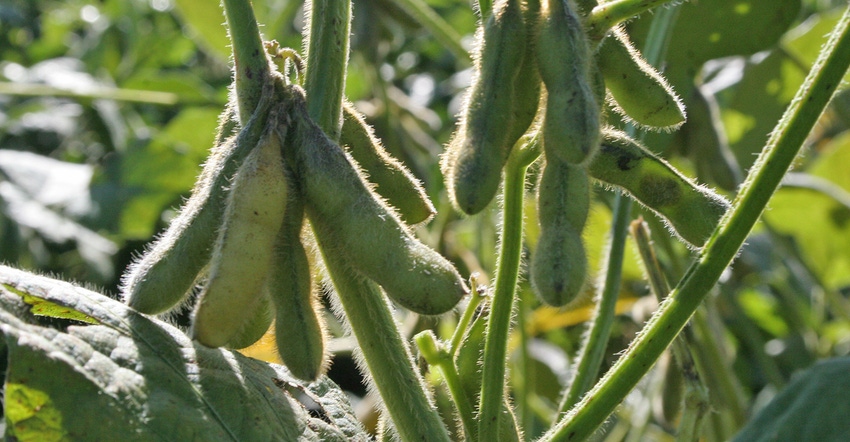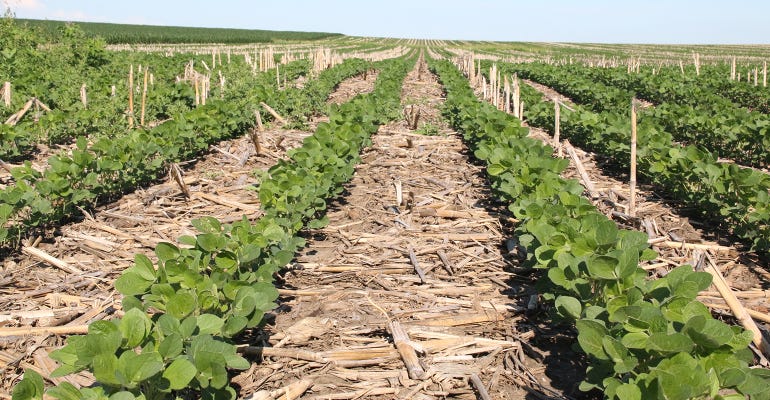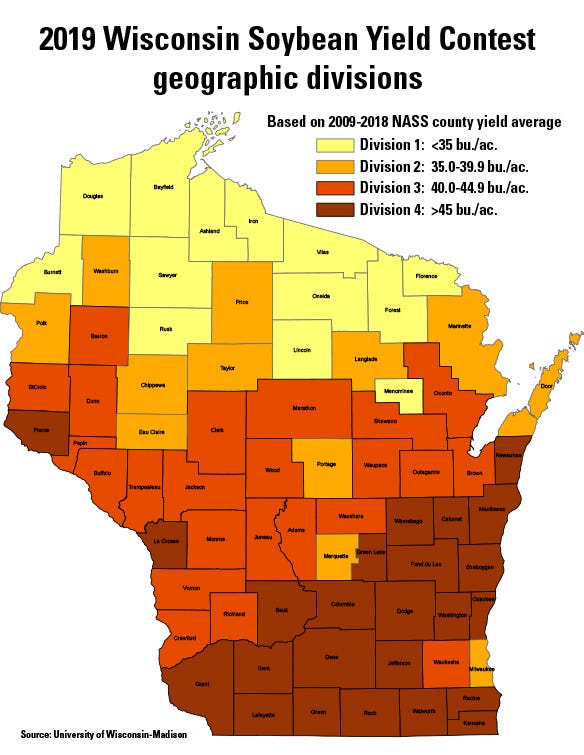March 29, 2019

Like most years, Mother Nature held the trump card during the 2018 soybean growing season.
“Looking at the long-range weather predictions, this most likely would have been a record-breaking year,” says Shawn Conley, University of Wisconsin-Extension soybean specialist. “However, rainfall totals in many areas were over 5 to 7 inches above normal. A multitude of storms often created flooding and created numerous drowned-out spots that resulted in overall yield losses of at least 5-plus bushels per acre.”
Conley notes that along with weather, growers should monitor three other factors that play a significant role in putting more soybeans in the bin.
First, strive to hit that early planting window. The optimum time table to achieve optimum yields is from April 20 to May 7.
Second, focus on season-long weed control — especially waterhemp, which seems to creep into more acres every year.
Third, don’t pass on fertility. Low grain prices may be creating input cash decisions, but adding potash will improve yield.
After eight years of overseeing the Wisconsin Soybean Association Yield Contest, Conley receives calls and emails from producers daily. “I’m constantly adding information to the website, tweaking my blog, and the students are always texting out photos,” he says. “My main message to growers is that they should think about managing soybeans as a key profitable crop and not as an afterthought to corn.”
Check out this year’s contest winners in three of the state’s four divisions. There were no entries submitted from Division 1.
Pushing 100 bushels per acre
Early planting, selecting the right variety, focusing on their overall production program and working closely with Insight FS in Darlington propelled Riley Brothers Farms to the highest yield ever recorded in the Wisconsin Soybean Association Yield Contest. Their 2018 contest plot measured 99.58 bushels per acre, exceeding their total of 92.1 bushels last year and earning them first place in Division 4.

The Rileys farm 5,000 acres of corn, which has averaged 235 bushels per acre the last five years, and alfalfa, with 1,500 acres planted in soybeans. Those no-till acres have averaged 70 bushels per acre during that time frame. Their contest plot of 40 acres, consisting of Dodgeville and Dubuque deep loam soils, follows a crop rotation of three years of corn and then soybeans.
Riley bases his fertility program from grid mapping and annual soil test results. In fall 2017, he applied 200 pounds of potash, 150 pounds of DAP (18-46-0) and 100 pounds of calcium sulfate per acre. On May 1, he no-tilled Asgrow AG2636 soybeans into 30-inch rows at 140,000 seeds per acre with a John Deere ExactEmerge 24-row planter. The moisture content when he harvested in mid-October was 13.5%, with a final stand of 132,000 plants per acre.
To control infestations of ragweed, waterhemp, marestail and lambsquarters, Riley went with a burndown of 1.5 pints of Boundary 6.5 EC herbicide per acre. He made a second pass that included 1.5 pints of Roundup per acre when plants were 1 foot tall.
Soybean seeds were treated with CruiserMaxx and Optimize. The fungicide program was 13.7 ounces of Trivapro applied with 3.5 ounces of Endigo insecticide to control frogeye leafspot and brown stem rot. A foliar feeding of 1 quart of NutriFuse 8-8-8 Super was put on with the Roundup and fungicide applications.
“For this geographical area, I feel that adding micronutrients, planting a proven variety, zeroing in on management practices, along with timely and adequate moisture at the optimum time, are the major factors to achieve 100 bushels per acre,” Riley says. “I like to enter the contest because I’ll concentrate a little more on soybeans and then make the effort to see if I can top that century yield barrier.”
Management boosts performance
Salentine Homestead Dairy LLC claimed first prize in Division 3 with a yield of 79.32 bushels per acre. That total is notably higher than the farm’s average of 64 bushels per acre over the past five years.

The Kewaunee County farmer planted the 85-acre plot with Steyer 1401 LibertyLink soybeans. Using a six-row John Deere planter outfitted with row cleaners, he dropped 160,000 seeds per acre in 30-inch rows. The moisture content at harvest on Oct. 12 was 15.8%, with a final stand of 150,000 plants per acre.
He applied Zidua Pro at a rate of 3 ounces per acre preemergence, two days after planting. The fungicide-insecticide package was BioForge and QuickRoots pre-inoculate (Optimize). Foliar feeding at the R3 to R4 growth stages included 2 ounces of Baythroid XL, 8 ounces of Steller Grow, 2 ounces of Stimulate and 1 pint of Sugar Mover per acre.
“After figuring my total input cost, the profit-per-acre difference between the contest and non-contest entry beans was $116 per acre,” Salentine says. “Planting early, selecting quality seed genetics, adding micronutrients, foliar feeding and favorable weather conditions, along with gleaning literature at the Corn/Soy Expo all played a role in achieving an excellent yield.
“It was exciting to receive the plaque for first place, especially after placing second in the division the past three years. The ultimate goal is to try and push this farm over that 100-bushel-per-acre yield barrier.”
Healthy plants deliver winning yield
Planting date, excellent plant emergence and focusing on weed control were the catalysts that helped Custer Farms from Chippewa Falls to the top spot in Division 2 of the contest.
“I believe late-season plant health was a primary factor in achieving 72.67 bushels per acre, nearly 24 bushels above our five-year average,” Doug Custer says. “It was the first time in many years for us to enter the contest and provided a good yardstick to truly monitor what this ground is capable of.”
Custer, his brother Darryl and father, Ken, farm 5,100 acres in Chippewa County. Besides 2,100 acres of soybeans, their crop inventory includes corn, ryegrass and alfalfa. The 75-acre contest plot consisting of Seaton silt loam soils follows a corn-soybean rotation. In early May, Custer minimum-tilled Asgrow AG19X8 soybeans into 15-inch rows with a DB60 47-row planter at 150,000 seeds per acre. His final stand at harvest on Oct. 24 was 145,000 plants per acre at 11.1% moisture.
The fertility package included 100 pounds of DAP, 125 pounds of potash preplant dry air-flowed, and 50 pounds of Amsul (AMS) per acre. To control giant ragweed and lambsquarters, Custer went with a preemergance and postemergence treatment of 4.5 ounces of Zidua Pro, 3.2 ounces of Roundup, 6 ounces of Engenia and 4 ounces of Priaxor per acre. Custer’s choice of seed-applied inoculants included Optimize, Trilex and Gaucho. His fungicide treatment was 4 ounces of Priaxor per acre at the R3 growth stage.
“In the past I have seen enhancements in trials using inoculants, but did not conduct a test this year,” he says. “In our long-range cropping program, soybeans are treated with the same importance as corn. There’s no special management treatment given to any field. The soil type teamed with sufficient moisture during the growing season were the building blocks for good yields this year.”
1st-year contender
Kreuziger Grain Farms entered the Wisconsin soybean yield contest for the first time in 2019. While the Juneau enterprise did not win in Division 4, the farm’s entry garnered the top spot in the state for protein and oil content, with 2,737 pounds per acre — more than 376 pounds above the winning total two years ago.

They planted Pioneer 22T41R2 beans with a 24-row Kinze 3800 planter in 30-inch rows, raising a final stand of 95,000 plants per acre. Soybeans were harvested on Oct. 19 at 13.1% moisture and yielded 85.74 bushels per acre.
Major weed infestations that pop up across most fields include marestail, lambsquarters, waterhemp, velvetleaf, Canadian thistle and dandelions. Their herbicide package was 0.825 ounces of Basis Blend, 4 ounces of Distinct and 2.2 ounces of Roundup per acre. A postemergence pass of Roundup, also at a rate of 2.2 ounces per acre, was applied on May 15, followed by 0.5 ounce of Cadet, 6 ounces of Select and 2.2 ounces of Roundup per acre on June 5.
The Juneau County farm’s seed-applied inoculant was Optimize. Foliar feeding included 1 pint of ZMB at the R3 growth stage and 4.5 ounces of Priaxor per acre as a precautionary fungicide treatment.
“Crop rotation, reduced tillage practices to limit compaction, evaluating seed genetics, planting early in ideal conditions, applying excess sulfur and relying on different herbicides all blended together to achieve an excellent yield and high protein and oil content,” Jerry Kreuziger says. “It was exciting and rewarding to see such high-end results and how our farm stacked up with other producers.”

DON’T PASS ON FERTILITY: Low grain prices may be creating input cash decisions, but adding potash will improve yield, Shawn Conley says.

Enter 2019 contest
Conley shares a list of guidelines for entering the 2019 Wisconsin Soybean Association Yield Contest. The contest is sponsored by the association and the Wisconsin Soybean Marketing Board, and was organized to encourage the development of new and innovative management practices, as well as show the importance of using sound cultural practices in state soybean production.
Any sound soybean system can be entered in the contest. Two winners will be selected from each of four geographical divisions in Wisconsin. Each division is based on long-term 10-year county soybean yield averages. Here are some guidelines for the contest:
To qualify for the 2019 contest, entrants must be at least 14 years old on Aug 1. More than one member in a family can enter, but each person must have a separate entry form and pay the fee. Any individual contestant may enter more than one entry in the contest.
The contest field must be in Wisconsin, and the contest entry must be at least 5 continuous acres. Contestants may select the best 5 acres in a soybean field larger than 5 acres and enter that variety.
The variety that is originally entered must be the same variety that is reported on the harvest report form.
The land entered in the contest must be owned or leased by the entrant. The variety entered must be commercially available.
There is a $25 fee (personal check) for each entry, which can coincide with the harvest date.
For the entry to be accepted, a supervisor’s name must be on the contest entry form, along with his or her title, address, telephone number and email. The supervisor is responsible for overseeing all computations and field measurements, and must be present during the harvesting, weighing and moisture testing.
The contest entry must be harvested in accordance with harvest procedures set forth by the Wisconsin Soybean Association. Harvests report forms are required to be completed and sent to Conley postmarked no later than seven days after harvest or Dec. 15 — whatever date is earlier. It’s the responsibility of the entrant to see that those forms are properly completed and mailed by the deadline.

Awards and recognition
Plaques and cash prizes will be awarded to the first-place ($1,000) and second-place ($500) winners in each geographic division. The winner is the entry that has the highest soybean yield based on bushels per acre at 13% moisture. In the event of a tie, both entrants will be recognized as co-winners.
Also, the first grower in the state that achieves 100 bushels per acre or more in the contest will be awarded a $2,500 check.
Each entrant is eligible to win only one plaque and cash prize. If an entrant has two or more entries and all the entries place, a plaque and cash prize will be awarded only for the highest-yielding entry. Awards will be presented at the Wisconsin Corn/Soy Expo in Wisconsin Dells next February.
Conley notes that producers are also encouraged to send in a grain sample, so they are eligible to receive a soybean quality award.
To review other contest and entry qualifications, visit coolbean.info or email [email protected].
Persinger writes from Milwaukee, Wis.
About the Author(s)
You May Also Like




